Description

Traditional Turkish Sedef Art
Sedef Art; the shining, playful, and reflected light of mother of pearl has attracted the attention of human beings since the beginning of the world. Societies, tribes, and nations have all added the technology of their day to their experience, knowledge, and understanding, and they have turned mother of pearl from one form into another. Though mother of pearl is quite widespread around the world, its assumption of the aspect of a magnificent branch of the arts after a past of many centuries began when it came into the hands of the Ottoman Turks.
Mother of pearl is the shell of mollusks such as mussels and oysters as well as of pseudopods (such as snails), though if we were to refer to it only as “shell” we would be slighting this extraordinary creation of God. When the young of these creatures come into the world they start their struggle to live. Up to a point, they need shelter, a house, in order to preserve their tiny existence, the reason being that they have many enemies. They undertake this business with a secret God-given force, and create the walls of their housing by means of layer upon layer of inexhaustible secretions, ensuring the harmonious continued growth of its house together with itself.
Please send us an e-mail if you are interested in participating our classes as individual or a student group.
Bazaar Turkey – Les Arts Turcs Art Studio
Alemdar Mh. Incili Cavus St.
No: 19 Floor : 3 (Behind The Underground Cistern)
Sultanahmet 34110
Istanbul, Turkey
Contact : Mr. Alp or Mr. Nurdogan ( Phone : +90 544 220 10 22 )
E-mail : info@bazaarturkey.com
Google Maps : https://goo.gl/maps/uXuyRmELZsx
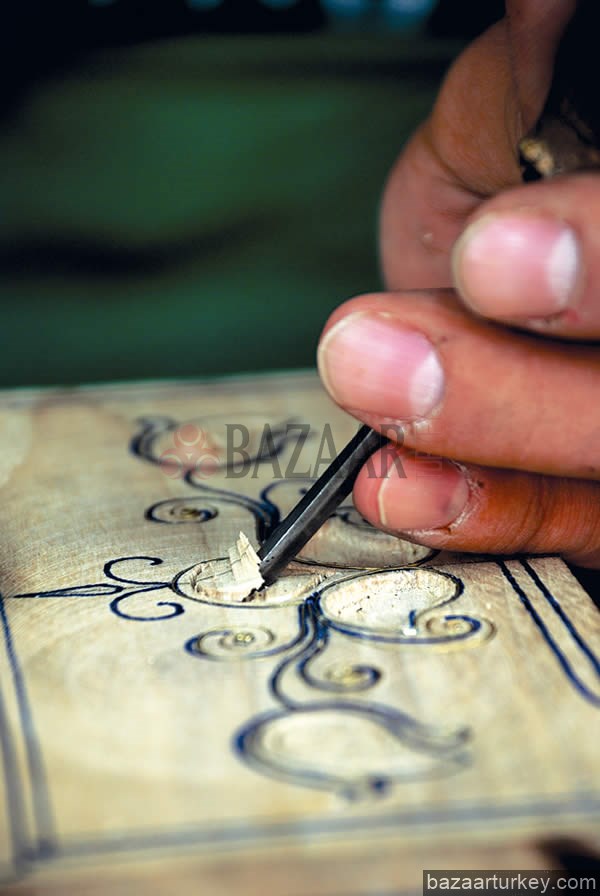
Traditional Turkish Sedef Art Workshop ( Per Student )
2 or more Student : 60 Euro
1 Student : 80 Euro
Lesson Includes.
- 2 Hours of Sedef Art workshops with all the materials.
- Basic or Advanced Level Lessons with Turkish Teachers.
- Lon term classes are available upon request
- Discount rates for groups.
History of Sedef Art – Mother of Pearls
The shiny quality of mother of pearl has always attracted attention. The different, unique decorations which children playing at the seaside make from the spiral shells and the shells of mussels and oysters of various sizes, which they collect with such excitement, are often encountered.
Let us take a look at information on this endeavour throughout history. In the Louvre Museum there are two objects belonging to the Sumerians and found in Mesopotamia representing a “wild goat entangled in branches”, and a “lion struggling with a bull”, also from the same provenance. The ample presence of pearl oysters in the Red Sea resulted in the working of various motifs in these shells. In addition, this type of work was also to be seen in Italy, Greece, and Cyprus. A dish consisting of geometric-shaped pieces of mother of pearl found in China and belonging to the Tang Dynasty (618-906) is evidence of the most ancient Chinese art of working in mother of pearl.
In Byzantium in the west and in Egypt in the east, the art of inlaying mother of pearl was not much used, but in its place, ivory assumed a fairly high level. Similarly, ivory assumed great importance in Iran and Iraq, and especially in Omayyad Spain. On an ivory chest in the Paris, Louvre Museum it is written that it was made for Abdurrahman Salisinoglu El Mugirat, Caliph of Cordoba, and it is dated 968.
It is known that mother of pearl and tortoiseshell were used in India in the 1560’s. In Indian Muslim objects however, ivory is predominant, and the gate of the Taj Mahal is a beautiful example of this.
Although there is no evidence to document the use of mother of pearl among the Turks of Central Asia, the existence of such objects is mentioned in Marco Polo and in the memoirs of several Byzantine ambassadors. In addition it is known that the Kazan Tatars made calligraphic inscriptions in mother of pearl.
Mother of Pearl Among the Ottomans
Although it is not known for sure at what date mother of pearl began to be used among the Ottomans, one can arrive at a date by an examination of Koran cases, writing desks, and chests which are signed by the craftsman making them and which are dated, as well as of window and door shutters and pulpits and lecterns in works of architecture. Researchers taking this approach point to the doors of Zagnos Pasha Mosque in Balikesir and of the Mosque of Beyazid II in Edirne as being the beginning of the art of working in mother of pearl among the Ottomans. Nevertheless, in his description of the funeral ceremony of Fatih Sultan Mehmed the Conqueror, Hocazade Saadettin writes that the sarcophagus was made of pure mother of pearl. Since such an object could be made at that date, we must put the beginning of the art of working in mother of pearl among the Ottomans back to a much earlier date. Unfortunately the tomb of the Conqueror has undergone various accidents at different dates, and for this reason, the sarcophagus has failed to survive down to the present day. The first of these accidents was the “Minor Judgment Day”, an earthquake which took place in 1509. The tomb also sustained damage in a major fire in 1782.
Reading Desk
Two sources have been used in works written on the history of the start of mother of pearl working: the first of these is 11. Asirda Türk Sedefçiligi (“Turkish Mother of Pearl Working in the 11th Century”) by Sahabettin, and the other is Cafer Çelebi’s Mimar Mehmet Aga ve Risale-i Mimariye (“The Architect Mehmed Agha and a Treatise on Architecture”). Both these works make mention of workshops in 15th Century Topkapi Palace in which the art of working in mother of pearl was taught.
Palace Workers in Mother of Pearl
According to the information in these two books, we may list the Palace workers in mother of pearl known in that period as follows:
Mehmet Usta was the master craftsman of mother of pearl at the Palace. Cafer Çelebi writes in his treatise that this person presided over the carpentry test the architect Mimar Agha.
Dalgi., Mehmet Aga rose to the rank of chief royal architect, and was counted among the master craftsmen of mother of pearl of the age. Two of his works are known today; the gate of the tomb of Murad III and a case for a section of the Koran in the Islamic Arts Museum.
Sedefkar Mimar Mehmed Aga was as famous for his work in mother of pearl as he was for his architectural works. It was he who produced the Mosque of Sultan Ahmed, a work which has earned the admiration of the world. The window and door shutters of the mosque consist of mother of pearl in geometric patterns. The upper portions of the window shutters contain scriptures done in mother of pearl. Expenses for mother of pearl workmanship in the account books maintained for the construction of Sultan Ahmed Mosque show the importance attached to this craft. According to these accounts, ten loads and 36,946 aspers were expended just for the mother of pearl work.
Mother of Pearl Outside the Palace
When we take a look at work in mother of pearl outside the Palace, the Travels of Evliya Çelebi casts light, albeit limited. According to one account in the Travels, before setting out on his expedition against Baghdad, Murad IV wanted all the classes of artisans to hold a ceremonial procession. In describing this procession in his work, Evliya Çelebi tells us that one hundred shop owners from the Süleymaniye complex and five hundred artisans participated in the ceremony together with a mother of pearl workshop which they set up on a palanquin.One of the most beautiful examples of the doors used quite often in palace architecture
(Hünkar Kasri, Yeni Cami)
Another locality outside the Palace which was engaged in working mother of pearl is said to have been the “Mother of Pearl Workers’ Market” in the district nowadays known as Tavuk Pazari. In the first years when mosques were constructed in the city, they were referred to by name, and it is for this reason that the Mosque of Hadim Ali Pasha, built in 1497, was known as Sedefçiler Camisi (“Mosque of the Mother of Pearl Workers”).
A Historical Appraisal
Known for centuries mother of pearl has always taken shape according to the technologies of the time and the artistic approaches of nations. In the 15th Century, mother of pearl became entirely at the disposal of Turkish Islamic art, and through various combinations it continued its development in which geometric forms were inexhaustible. Later, Seljuk-style motifs (which made various compositions possible through such means as coils, branching, connection by means of intermediary or supplementary ties, intersections, and knotting) began to be used together with geometric designs, as were flower motifs (tulips, carnations, and roses) taken from nature and stylized.
The 17th Century was the peak of achievement for the art of working in mother of pearl. With the addition of a suddenly worsening economic structure to the popularity of baroque art in the following century and in later years, the art was strayed from, and cheap works lacking any artistic value began to be produced. Nevertheless, the Palace art of mother of pearl working was still preserved during the reign of Abdülhamid, in order to be able to provide foreign potentates and diplomats with gifts of the material.
Vasif Hoca, a master in mother of pearl of the recent past (it was he who made the door of the Holy Relics Room using mother of pearl and tortoiseshell) continued his work in his private workshop while at the same time sought out ways to ensure that the art would survive. He gave lessons in mother of pearl work at Nefise-i Sanayi, the Academy of Fine Arts of the day. With the death of this master in 1940, the handing down of this branch of the arts to new generations unfortunately came to an end.

White Mother of Pearl: This is from pearl-bearing oysters. Its reflective properties are high and it is one of the most commonly used types of this material.
Iridescent Mother of Pearl: This is a type in which the colours of pink and green are predominant.
Chip (Variegated) Mother of Pearl: This is a multicoloured type.
Stone Mother of Pearl: This type of mother of pearls is white and has low reflective power.
Mat Mother of Pearl: This type of mother of pearl is dull grey and has a low reflective power.
Techniques Employed in Mother of Pearl
The techniques employed in mother of pearl work may be listed as follows:
The Inlaying Method
The Gluing Method
The Paste Method
In the inlaying method, the surface which is to be decorated in mother of pearl is marked with a hard point. The grooves of thin designs to consist of wire, ivory, or bone are opened with a fine chisel and the material is set into them. The motifs whose outlines are thus drawn are carved out to a depth of two or three millimetres using gouges and prepared for the mother of pearl inlays. The use of wire in the inlaying method is known as “Damascus Work”. In “Istanbul Work” on the other hand, bone or ivory is more often used rather than wire.
In the gluing method, no carving takes place on the surface. Instead, the mother of pearls is made to adhere to the surface by means of auxiliary substances.
In the paste method (or scattering method) mother of pearl in small pieces is made to adhere sometimes on a definite line, sometimes at random. The interstices are filled in with a paste of a colour which harmonises with the auxiliary material being used in the work.
Auxiliary Materials Employed Along With Mother of Pearl Wood
The art of mother of pearl working is a branch of the arts which is intimately involved with wood. One needs to chose one’s wood according to the method of the work to be done. In the inlaying method, one uses walnut, which is suitable for carving and does not become brittle upon carving. In the gluing method on the other hand, the wood must be of an even-tempered nature. Linden, which is unaffected by heat or cold, and which maintains the same straightness for years -ever centuries- is the wood most suited for this technique. In the gluing technique, the surface may be covered entirely in mother of pearl, or else, auxiliary materials may be used together with it.
Fillets
Fillets are thin strips which are obtained by painting long narrow strips of wood or veneer in different colours. Bone and ivory may also be placed among colored veneer. Depending upon the colour of these fillets and the order the arrangement of the ivory, they may be given such names as “leavened”, “rat’s tooth”, “row”, and “puzzle”. Fillets are used to distinguish designs and compositions from one another, to bind them together, and in some cases to fuse them; they occupy an important place in mother of pearl working. The manufacture of fillets is quite advanced in Damascus. Indeed, when these fillets are lined up side by side, one achieves a variety of motifs. Although Damascus work fillets are multi-colored, those used in Istanbul work have a plain appearance. The edging decorations at different angles, and which have such names as “small chain”, “border”, “flight”, “linked”, and “rim”, have such beautiful examples that they appear lovelier than the whole work itself.
Tortoiseshell
This is actually the topmost shell of a sea tortoise. Owing to its translucent appearance, its ability to hold a high polish, and its resistance to wear, it has always been mother of pearl’s closest friend. Tortoiseshell may be used in its naturel state, and similarly, it may be used with its inner surface colored. As a result of this coloring, one can obtain a dark red or golden hue. To achieve a dark red, the inner surface of the tortoiseshell is painted with a liquid obtained by mixing red lead or cinnabar with glue. To obtain a golden colour, one must use gilt leaf or else some other material which will achieve the same effect.
Ivory and Bone
Ivory comes from the tusks of elephants. Bone on the other hand is from the fibulae of large animals such as camels and cattle or from the ribs of water buffalos.
Types of Mother of Pearl Objects
Mother of pearl objects are named according to the techniques of their manufacture and according to the region in which they are made. In that respect, we may list the types of mother of pearl objects as follows.
Istanbul Work
Damascus Work
Vienna Work
Jerusalem Work
Istanbul Work
At the “Exhibition of Prayer Beads and Prayer Bead Making “held a short time ago by Antika, Niyazi Sayim, came up to the lectern to give a talk, and described the following event. “We were doing some work for music on the radio when Messut Cemil bent over and said into my ear; ‘What you’re doing is called not ‘Turkish Music’ but ‘Istanbul Music’. Prayer beads have been known and produced in quite a few societies, but the most beautiful ones have been made in Istanbul. This is also said for our calligraphic arts, a fact which makes one proud indeed. The Holy Koran descended from Heaven at Mecca and it was recited in Egypt, but it was at Istanbul that it was written.” To this, I would like to add the following: mother of pearl was born all over the world, grew, and was loved; nevertheless it was in Istanbul that it became a branch of magnificent art. Works consisting of mother of pearl, tortoiseshell, and ebony have been a source of pride for those making them, using them, and giving them as gifts. In passing from one form to another in the hand of masters, mother of pearl has assumed new names with each change, names such as “spotted”, “zigzag”, “camel’s tooth”, “lake”, “dagger”, cinquefoil”, “carnation”, “daisy”, “moon”, “cloud”, “barley”, “star”, which have either risen to the sky or opened up into the fields, and stylising the most beautiful of plants and flowers, brought them into our palaces and architectural works, and even into our homes.
Damascus Work
Damascus work involves the inlay technique, and consists primarily of almond motifs. The lines around the mother of pearl which make the motifs apparent are done in wire which is an alloy of tin and lead. The mother of pearl employed is usually the mat type. In Damascus work which is done using the gluing technique, fillets are used abundantly, while mother of pearl is used extremely sparingly.
Vienna Work
As may be understood from the name, this is a type of mother of pearly work which grew up outside the Turkish tradition. A system is employed involving paste and glue among fillets of brass. Pieces of mother of pearl are made to adhere like a mosaic. The mother of pearl is iridescent green and white, while the furniture is a polished black.
Jerusalem Work
The presence of an abundant supply of pearl oysters in the Red Sea ensured that this art would spread throughout the region. Objects are produced from pure mother of pearl or using the gluing technique, and are given shape by carving them with sharp steel gouges. Motifs consist of stylised branches and flowers. Objects of this style include small articles such as mirror frames, models of the Mosque al-Aqsa, ashtrays, and plates.
Source: Antika, The Turkish Journal of Collectable Art-October 1986 issue: 19

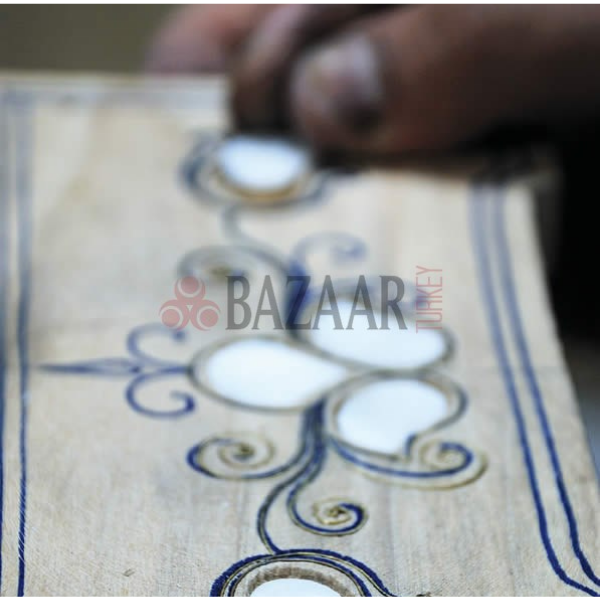
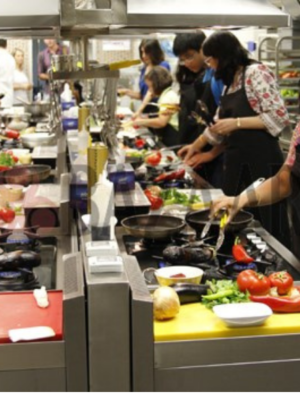
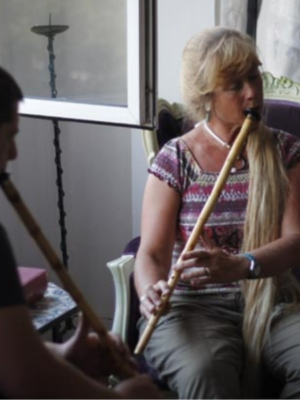
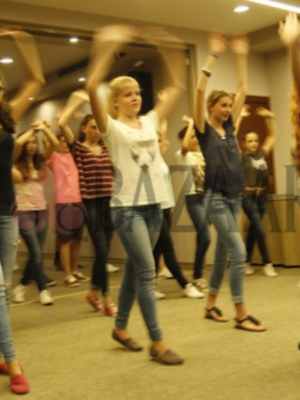



Reviews
There are no reviews yet.